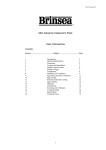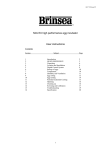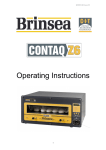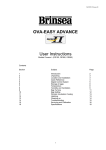Download Brinsea Octagon 20 ECO User's Manual
Transcript
AE21 GB Issue 02 Octagon 20 Eco and Octagon 40 Eco egg incubators User instructions Contents Section 1 2 3 4 5 6 7 8 9 10 11 12 Subject Introduction Unpacking Location, Installation and Temperature Storage of eggs Humidity and Ventilation Egg setting Egg turning Hatching Cleaning up Servicing Troubleshooting Specifications 1 Page 2 2 3 5 5 8 8 8 9 9 10 11 AE21 GB Issue 02 1 Introduction Read the instructions before use. These instructions detail the operation of your new Octagon 20 Eco or Octagon 40 Eco incubator and optional Autoturn Cradle. Please read these instructions carefully before setting up your machine to achieve best results and keep these instructions safe for future reference. This document includes recommended procedures for successful hatching but incubation involves the control and manipulation of a large number of factors and in certain circumstances different procedures may be necessary. Your incubator is designed to allow the user to vary the incubation conditions to suit a wide range of species in different ambient conditions and the specific setup for every situation is beyond the scope of these instructions. There is a range of books available covering incubation techniques, for more information or to request a book list please don’t hesitate to contact us. DO NOT COVER THE INCUBATOR. FOR INDOOR USE ONLY. THE INCUBATOR MUST BE PLACED IN AN AREA NOT SUBJECT TO SPLASHES OF WATER OR WET CONDITIONS AND OUT OF REACH OF ANIMALS AND CHILDREN. Fig. 1 Functional features of the Octagon 20 Eco (Octagon 40 Eco functionally similar) Temperature Control Housing Heater Indicator LED Cable / Adjustment Spindle Cover (remove to access tamper-proof temperature adjuster) Liquid-in-glass Thermometer Turning Motor Housing Adjustable Air Vent Autoturn Cradle 2 Unpacking Your incubator has been supplied in protective packaging. Please remove all tape, strapping and packing from the incubator and parts. Retain the carton and packing materials to enable the unit to be repacked. Your incubator will include as standard: Quantity (Octagon 20 Eco) Quantity (Octagon 40 Eco) Item 1 1 1 1 6 1 2 1 1 12 Incubator (including removable lid) Egg tray Cable cover and screw Mains cable Wire egg dividers 2 AE21 GB Issue 02 Optional Autoturn Cradle:2 1 1 1 Base bars Motorised cradle end Plain cradle end Set of four bolts 2.1 Please identify each part and check that they are all present and undamaged. If there are any parts damaged or missing please contact your retailer or Brinsea Products (at the address at the end of the document). Damaged appliances shall not be used. 2.2 Check also that the electrical supply matches the machine’s requirements (marked on the technical label on the inside of the lid of the incubator and on the inside of the blank Autoturn cradle end). The power cord set must be an appropriately rated and approved cord-set in accordance with the regulations of the country it is used in. 2.3 To register your new Brinsea product please visit www.brinsea.co.uk and follow the link on the right hand side of the home page to qualify for your free 2 year guarantee. 2.4 Go to www.Brinsea.co.uk and register as a free member of the Brinsea Email Group to receive the latest news and information such as advance notice about new products, special offers, exclusive competitions and much more. 3 Location, Installation and Temperature 3.1 Your incubator will give best results in a room free from wide temperature variations and with generous ventilation – particularly if several incubators are running at the same time. Ensure that the room temperature cannot drop on a cold night. Ideally thermostatically control the room at between 20 and 25°C (68 and 77°F). Never allow the room temperature to drop below 15°C (59°F) and ensure that the incubator cannot be exposed to direct sunlight. Do not use your incubator on the floor. 3.2 If using the Autoturn cradle: Assemble the Autoturn cradle in accordance with the diagram below (Fig. 2) and place on a flat, level surface (workbench height is ideal). Place the incubator into the Autoturn cradle as illustrated (Fig. 1). The cabinet is designed to locate onto the lugs at either end of the Autoturn cradle. Take care to offer the incubator at the angle which matches that of the drive lug to avoid damage to the mechanism. Ensure full engagement in the slots in the ends of the incubator so that the incubator is level end to end. FIG. 2 3.3 If using without the Autoturn cradle place the incubator upright on a flat level surface. 3.4 Remove the lid and place it where it can not be splashed by water. Lift out the egg tray and fill one of the two water channels (Octagon 20) or two of the four water channels (Octagon 40) with water or 100:1 Brinsea Incubation Disinfectant Solution leaving the top of the liquid 3/4” (20mm) from the top of the channel. Replace the tray and replace the lid. Slide the ventilation control to the centre of its range. 3 AE21 GB Issue 02 3.5 Connect the mains cable to the incubator lid. Ensure the connector is pushed fully home in its socket; it may be quite a tight fit. Octagon 40 only 3.6 Plug the incubator mains supply cable into a suitable outlet ensuring that the cable is not pulled tight. The incubator fan will start and the red LED in the temperature control housing will light continuously. Allow the incubator to run for at least an hour to stabilise the temperature before making adjustments or setting eggs. Stable and correct temperature is essential for good results. Adjust with care. Please note: your incubator may not be set to the correct temperature from the factory and the following procedure must be followed before setting eggs. 3.7 As the incubator warms up and approaches its control setting the red heater indicator LED will change from continuously on to flashing. Allow the incubator to stabilise for at least an hour before adjusting the temperature. 3.8 Rotate the red adjustment spindle located in the cable connector housing with a small screwdriver – clockwise to increase temperature, anticlockwise to reduce it. 1°C (2°F) is about ¼ turn of the spindle. Refer to the thermometer to check temperature. Adjust temperature with care – small differences have large effects on hatching performance. When reducing temperature the red LED may go out while the incubator cools – this is normal. Red Adjustment Spindle 3.9 Recommended temperatures: Typical incubation period: Hens 37.4 – 37.6°C 99.3 – 99.6°F 21 days Pheasant 37.6 – 37.8°C 99.6 - 100°F 23-27 days Quail 37.6 – 37.8°C 99.6 - 100°F 16-23 days Ducks 37.4 – 37.6°C 99.3 – 99.6°F 28 days Geese 37.4 – 37.6°C 99.3 – 99.6°F 28-32 days Amazons 36.8 – 37.0°C 98.3 – 98.6ºF 24-29 days Macaws 36.8 – 37.0°C 98.3 – 98.6ºF 26-28 days Love birds 36.8 – 37.0°C 98.3 – 98.6ºF 22-24 days African Grey 36.8 – 37.0°C 98.3 – 98.6ºF 28 days Eclectus 36.8 – 37.0°C 98.3 – 98.6ºF 28 days Parrots: 4 AE21 GB Issue 02 3.10 Developing embryos are fairly tolerant of short term temperature drops and the user need not be concerned about cooling that occurs when inspecting eggs. Temperatures above ideal can quickly have a serious detrimental effect on hatch rates and must be avoided. 3.11 Once the correct temperature has been achieved the cable cover must be fitted to ensure the cable is correctly clamped and the connections are fully protected from splashes of water. Fit the Cable Cover and gently tighten the screw. DO NOT ROUTINELY OPERATE THE INCUBATOR WITHOUT THE CABLE COVER IN PLACE. ENSURE THE CABLE IS NOT CRUSHED OR PINCHED WHEN THE COVER IS FITTED. The cover is designed to prevent splashes of water reaching the electrical socket and it clamps the cable to prevent the connector coming loose. 3.12 Plug the cradle mains supply cable into a suitable outlet ensuring that the cable is not pulled tight. The cradle motor will start and the incubator will begin to turn. Please note:- The turning is very slow – taking about half an hour to turn each way. 4 Storage of Eggs 4.1 Store eggs in cool, damp conditions. Most species may be safely stored for up to 14 days before serious reductions in hatch rates are likely. Daily turning of stored eggs also helps maintain hatchability. 4.2 Discard cracked, mis-shaped and heavily soiled eggs (if possible). Only wash soiled eggs using a brand egg wash solution such as Brinsea Incubation Disinfectant Concentrate following the manufacturer’s instructions. It is essential to wash eggs in solution which is significantly warmer than the egg. Bear in mind that all solutions will remove the outer cuticle from the egg as well as the dirt and may leave the egg at greater risk from bacterial contamination in the future. 5 Humidity and Ventilation Short term variations in humidity are not important. The average humidity over the incubation period needs to be near optimum to achieve the ideal weight loss. High humidity for the day or two of hatching is also important. Beware chronic, excessive humidity. 5.1 Two factors affect incubation humidity: water evaporation within the cabinet (from eggs as well as from additional water) and levels of ventilation. The water content of the air being drawn through the incubator will also have an effect. 5 AE21 GB Issue 02 5.2 There are three methods available to bird breeders to achieve correct humidity levels: a) Follow the manufacturer’s guidelines for water and ventilation levels (see below). b) Measure humidity levels and adjust to match published guidelines for different species (see below). c) Monitor egg weight loss which varies as a direct result of humidity and correct against published weight loss figures for the species. a) As a general guide for poultry set the ventilation control to about half open and maintain water in one of the water channels. If the incubator is not full reduce the ventilation level accordingly. If the incubator is full of parrot (and parrot like species) eggs the ventilation control should be about 2/3rds open. If fewer eggs are incubated reduce the ventilation level accordingly. For all species ensure there is water in all channels for the last two days of incubation. Higher humidity levels are needed for hatching to prevent membranes drying too quickly. Do not close the vent below 1/3rd when hatching. The above guidelines make no provision for different ambient conditions and are necessarily rather generalised but they are simple and often effective. b) If measuring humidity levels directly be cautious of readings from low cost analogue or digital hygrometers. Generally accepted incubation RH levels for species groups: During incubation Poultry Waterfowl Parrots 40-50% RH 45-55% RH 35-45% RH Hatching All species 65% RH or more For more specific information on particular species’ requirements check the relevant literature. c) Eggs lose moisture through their shells and the rate of evaporation depends on the humidity levels around the eggs and the shell porosity. During incubation eggs need to lose a fixed amount of water which corresponds to a loss in weight of around 13-16% depending on species. By weighing eggs periodically during incubation it is possible to monitor and, if necessary, correct humidity levels to achieve the correct weight loss. Weigh the eggs on the day they are set in the incubator, take the average weight and plot this on a graph (see example below). The ideal weight loss line can be plotted by joining the point representing initial average weight with the ideal hatch weight (13-16% less depending on species) with the x-axis representing the incubation period (in days). By measuring actual average weights every few days the actual weight loss can be plotted and compared to the ideal weight loss line and corrections can be made. For example if the actual weight loss was greater than ideal (see graph below) then the air has been too dry and humidity levels need to be increased to compensate. Typical ideal weight losses for species groups: Poultry Parrots Waterfowl 13% 16% 14% 6 AE21 GB Issue 02 Average egg weight (grams) Egg weight loss chart Ideal weight (grams) 68.0 66.0 64.0 62.0 60.0 58.0 56.0 54.0 Measured weight (grams) Incubation period (days) 5.3 Of the three methods given above the most reliable is egg weight method and is recommended – particularly where poor hatch rates are experienced or if eggs of high value are being incubated. 5.4 Alter the setting of the ventilation control (reduce ventilation to increase humidity) and have water in neither, one or more of the water channels to change the humidity level. Humidity levels may be further increased by placing strips of evaporating card or cloth into one or more of the water channels. Evaporating card is available from Brinsea Products. Folded evaporating card 5.5 In all cases the humidity for hatching needs to be high. Because of the short duration involved water/weight loss will not be significantly affected. High humidity is necessary to prevent membranes drying and hardening before the hatch fully emerges. Humidity will naturally increase as the first eggs begin to hatch and internal membranes begin to dry. This effect is in addition to the increased area of water evaporation from the water channels. 5.6 During hatching the high humidity levels will fall dramatically when the lid is opened and will take some time to build up. Resist the temptation to lift the lid frequently – leave for at least 6 hours between inspections. 7 AE21 GB Issue 02 6 Egg Setting 6.1 The Octagon 20 Eco and Octagon 40 Eco are designed to be as flexible as possible, accommodating eggs of different sizes up to (and including) goose eggs and in different orientations. Some experimentation may be necessary to maximise capacity. 6.2 Before setting eggs ensure that the incubator has been run for several hours and has stabilised at the correct temperature. 6.3 Set the eggs in rows between the wire loop dividers. The dividers must be positioned such that the eggs rest on the tray bottom and are not pressured by the bar. The dividers prevent the eggs rolling. Eggs may be set on end (or at an angle) provided the large end of the egg is upwards. Eggs rolling through a few degrees between the dividers as the incubator turns are not in danger. 6.4 Once the eggs have been set the temperature must not be adjusted for 24 hours to allow the eggs to warm. Check the water level every 3 days or so and temperature daily. Candle the eggs after 1/3rd of the incubation period has elapsed to reject clear, infertile eggs (see section 12). 7 Egg Turning Warning: NEVER MANUALLY TURN THE INCUBATOR WHILE IT IS ON THE CRADLE, this will damage the turning mechanism and invalidate the guarantee. THE AUTOTURN CRADLE ASSEMBLY IS FITTED WITH A CLUTCH. IF A CLICKING SOUND IS HEARD THIS INDICATES OVERLOAD OF THE TURNING MECHANISM. The cause of this may be overloading of eggs or other objects impeding the turning of the incubator. Ensure the incubator is not overloaded and that nothing can restrict the movement of the incubator (such as a mains cable or having the incubator too close to a wall). This may damage the turning mechanism and invalidate the guarantee. 7.1 The Autoturn cradle will continuously turn the incubator and eggs on an hourly cycle (through 90° and back) while plugged into the mains supply. Some small intermittent movement due to play in the gears is normal and does not cause harm. Lubrication of the plastic linkage with WD40 helps to ensure smooth, silent movement. 7.2 Ensure that nothing can impede the movement of the incubator on the cradle (such as a mains cable or having the incubator too close to a wall). 7.3 Altricial species such as parrots or birds of prey may benefit from additional manual turning through a full 180° once or twice a day. 8 Hatching 8.1 If hatching in the Octagon 20 Eco or Octagon 40 Eco unplug the Autoturn cradle, remove the incubator from the cradle, place on the work surface in the upright position and remove the egg dividers two days before the hatch is due. 8.2 For maximum setting capacity, cleanliness, flexibility and performance a separate hatcher may be used. A second Brinsea Octagon 20 or 40 is recommended. Contact your dealer for details. 8.3 Eggs nearing hatch are slightly less sensitive to temperature variation and the hatching temperature can be reduced by up to 1°C (2°F) but this is not essential. 8.4 Hatching humidity levels need to be high (see section 5 above) but note that the ventilation control must be at least 1/3rd open during hatching. 8 AE21 GB Issue 02 8.5 When most eggs have hatched (12 to 48 hours) remove the hatchlings to a brooder. The Brinsea EcoGlow is ideal for poultry and waterfowl etc. The Brinsea TLC-40 or TLC-50 Brooder is recommended for exotics. 8.6 During hatching the high humidity levels will fall dramatically when the lid is lifted and will take some time to build up. Resist the temptation to open the incubator frequently – leave for at least 6 hours between inspections. 9 Cleaning Up IMPORTANT: DISCONNECT THE INCUBATOR AND CRADLE FROM THE MAINS POWER SUPPLY DURING CLEANING. RISK OF ELECTRIC SHOCK! ENSURE THAT ALL ELECTRICAL PARTS ARE KEPT DRY. DO NOT IMMERSE THE YELLOW BASE. 9.1 NEVER WASH THE TRAYS, COVERS OR CABINET PARTS IN LIQUIDS OVER 50°C (120°F). DO NOT USE A DISHWASHER TO CLEAN TRAYS, INCUBATOR BASE OR LID. Following each hatch remove and wash the egg trays and dividers in Brinsea Incubation Disinfectant Solution. Wipe all other internal surfaces with a soft cloth soaked in the solution. Do not immerse the hollow yellow base as fluid may become trapped inside. Ensure that the instructions supplied with the fluid are followed. 9.2 Periodically unscrew the screws retaining the fan cover, remove the cover and soak. Dust and fluff may be removed from the fan(s) and heater cord with a soft brush. USE NO LIQUIDS. THE INCUBATOR MUST NOT BE USED WITHOUT THE FAN COVER FITTED. RISK OF ELECTRIC SHOCK! WARM AIR DISTRIBUTION WILL BE ADVERSELY AFFECTED IF THE FAN COVER IS NOT IN PLACE. 9.3 If a separate hatcher is used the procedure above should still be followed every two months. 9.4 The exterior of the incubator and Autoturn cradle may be cleaned with a damp cloth. Avoid allowing any moisture to get inside mechanical housings. 9.5 Always clean the incubator before storage and ensure that the unit is totally dry inside and out. Run the incubator with no water inside for 24 hours prior to storage to ensure it is completely dry. 10 Servicing IMPORTANT: THE HEATER CORD AND CONNECTIONS ARE AT MAINS VOLTAGE. NEVER OPERATE THE INCUBATOR WITH THE FAN COVER REMOVED. RISK OF ELECTRIC SHOCK! 10.1 In case of failure first check that the mains power supply is working and that the mains cable connector is fully engaged in the socket beneath the cable cover. If the problem persists contact your distributor or Brinsea Products Service Dept. 10.2 No lubrication or further servicing is required beyond the instructions above. 9 AE21 GB Issue 02 11 Troubleshooting 11.1 Poor hatching results are frustrating and can be caused by a large number of factors. The most common are given below. Brinsea Products will not be held responsible for loss of eggs or chicks under any circumstances. However we will try to advise on incubation technique to improve results where necessary. 11.2 Gather as much information from the hatching results as possible to enable the problem to be analysed in detail. Record dates that eggs are set, incubator settings, dates of hatches, weight losses and the number and condition of hatchlings. Candle or break open unhatched eggs to estimate the extent of embryo development. The Brinsea OvaView and High Intensity OvaView candling lamps are available from your dealer. 1 2 1 10 20 3 7 4 5 6 1) Clear when candled - probably infertile (or very early death) when candled at 8 days 2) Fertile with red blood vessels - after 8 days 3) Red or black staining - early death when candled at 8 days 4) Embryo with red blood ‘ring’ - early death when candled at 8 days 5) Dark outline with ill defined detail - late death (10-16 days) 6) Live embryo with bill in air sack - due to hatch in 24-48 hours 7) Normal development of the air pocket according to number of days General guides: Observation No chicks hatch Likely Cause(s) Infertility, infection, drastically incorrect incubation settings, parent ill health. Chicks hatch earlier than expected, deformities. Chicks hatch later than expected Hatch dates widely spread Incubation temperature too high Late stage ‘death in shell’ Generally poor results Incubation temperature too low Different rates of development due to different storage times, incubation temperature variation. Incorrect humidity, probably too high. Incorrect incubation settings, poor parent bird health, inadequate egg turning, 10 Solution(s) Check egg viability – are similar eggs hatching naturally. Disinfect the incubator. Check incubator settings and procedures – particularly temperature. Reduce incubation temperature slightly 0.5°C (1°F) Raise incubation temperature slightly 0.5°C (1°F) Limit egg storage times. Check for incubation temperature variation – sunlight, large room variation etc. Try reducing average humidity levels (but see section 8 above) Improve parent bird health, check all incubation settings, analyse egg weight loss to confirm humidity correct, check turning working correctly. AE21 GB Issue 02 12 Specification Maximum Setting Capacities: Octagon 20 Advance Octagon 40 Advance Egg size Typical capacity Typical capacity Quail Pheasant Amazon/Macaw Hen Duck Goose 60 40 36 24 20 9-12 120 80 72 48 40 18-24 Incubator only Including Autoturn Cradle 35cm x 26cm x 26cm high 43cm x 26cm x 30cm high 65cm x 26cm x 26cm high 73cm x 26cm x 30cm high Weight: Incubator only Including Autoturn Cradle 2.70 Kg 3.25 Kg 4.20 Kg 4.80 Kg Power Consumption: Maximum (typical average) Autoturn cradle 45 Watts 25 Watts 4 Watts 90 Watts 40 Watts 4 Watts Electrical Supply: 230v 50Hz 230v 50Hz Dimensions: Brinsea Products Ltd, Station Road, Sandford, N. Somerset, BS25 5RA Tel: 0845 226 0120 Fax: 01934 820250 e-mail: [email protected], website: www.Brinsea.co.uk 11 AE21 GB Issue 02 Declaration of Conformity We: BRINSEA PRODUCTS LTD. Station Road Sandford North Somerset BS25 5RA Declare under our sole responsibility the products: Egg Incubators: Octagon 20 Eco (Serial numbers AE21x/xxxxxxxxx, AE22x/xxxxxxxxx) Octagon 40 Eco (Serial numbers AE42x/xxxxxxxxx) to which this declaration relates are in conformity with the following EU Directives: 2006/42/EC Machinery Directive 2004/108/EC Electromagnetic Compatibility Directive The relevant sections of the following Standards have been used: EN 60335-1:2002+A14:2010 EN 60335-2-71:2003+A1:2007 EN 55014-1:2006+A2:2011 EN 55014-2:1997+A2:2008 The technical documentation for the products is available from the above address. Authorised Representative: Ian Pearce, Managing Director Signature: Date of Issue: 20/02/2012 Place of Issue: Station Road, Sandford, North Somerset, BS25 5RA, United Kingdom. 12















